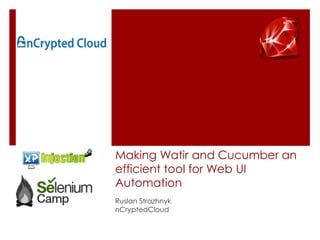
Making Watir and Cucumber an efficient tool for Web UI Automation
- 1. Making Watir and Cucumber an efficient tool for Web UI Automation Ruslan Strazhnyk nCryptedCloud
- 2. About Me Ruslan Strazhnyk Rich experience in creating Test Automation Frameworks - Front-end, Back-end, API, Load Testing Languages: Ruby, Python, Java, JS Technologies: Selenium, REST, CI, Jenkins, Jmeter
- 4. Why Not Robot Framework? Pros Similar to BDD/ATDD test writing Page Object implemented through Selenium2library plugin Possible to write extensions in Python Produces output in html Cons Requires building own framework (with extensions) Requires learning RF own language for writing test scenarios Indirect webdriver support through Selenium2library Tests are written in txt files
- 8. Why not Behave? Pros BDD/ATDD is supported through Gherkin Libraries in Python Produces output in json and html Latest webdriver library supported More cucumber-like, better than RF in keyword logic Cons Page Object is not supported out-of-the-box Building custom framework layer required Only basic usage tutorials are available
- 9. Behave
- 10. Behave
- 11. Why not some fancy JS Framework? Node.js + protractor.js + webdriver.js Pros BDD/ATDD is supported through Gherkin in cucumber.js Page-object through protractor.js Fresh and buzzy Robustly works with angular applications Output in html and json Cons Strong knowledge of JS required Only some basic tutorials available Immature frameworks, too many of them Has a high-entry point, more optimized for e2e testing
- 15. Why Ruby/Cucumber/PageObje ct/Watir? Pros Full support of Cucumber Advanced Page-Object framework as a gem Rspec makes mocking and assertion more advanced Excellence of both watir and webdriver Nice book fromJeff Morgan – “Cucumber and Cheese” Cons Can be a separate language stack Learn other ruby gems for things like mysql, ssh and so on
- 16. Advantages of Watir No xpath No Selenium IDE The power or Ruby Rich API
- 17. Page-object gem for Ruby https://github.com/cheezy/page-object Assists in creating flexible page-objects for testing browser based applications Facilitates creation of abstraction layers in the tests and makes decoupling easy Provides simple API interface to the elements on a page
- 18. Page-object gem for Ruby Works with both watir-webdriver and selenium- webdriver Robust way of dealing with Ajax Calls A clean way of handling JavaScripts pop-ups A simple way of dealing with Frames and iFrames Supports most HTML elements
- 19. Page Object Define new page object Add some methods, let’s say for login page
- 20. Creating Page Object It is possible to create higher level methods that hide implementation details even further So usage of the page would become
- 21. Page Object Elements Button Cell Checkbox Div FileField ttps://github.com/cheezy/page-object/wiki/Elements Form H1, H2, H3, H4, H5, H6 Hidden Field Image Link
- 22. Page Object Elements ttps://github.com/cheezy/page-object/wiki/Elements ListItem OrderedList Paragraph RadioButton SelectList (Dropdown) Span Table TableCell TextArea/TextField UnorderedList
- 23. Hooks Scenario hooks Before After Around Step hooks Tagged hooks Global hooks AfterConfiguration
- 24. Hooks Before and After hooks
- 25. Tagging You can use tags to mark your scenarios Some tags are user for hooks There could be many tags for one scenario Effective execution of needed test scenarios
- 26. Tagging
- 27. Scenario vs. Scenario Outline Use different values instead of multiplying scenarios Allows to more concisely express the example through the use of placeholders Scenario Outline steps provide a template which is never directly run Problematic for some cucumber Reporting plug-ins in Jenkins
- 28. Scenario vs. Scenario Outline
- 29. Advanced element usage File Upload (steps and step definitions)
- 30. Advanced element usage File Upload (function)
- 31. Advanced element usage Looping through file links
- 32. Advanced features: iFrame, inFrame
- 33. Advanced features: iFrame, inFrame
- 34. Advanced features: JS Pop-ups Alert, Confirm, Prompt
- 35. Continuous Integration with Jenkins RVM plugin for executing tests in RVM env Cucumber-reports or Cucumber Test Result Plugin for reporting Xvfb plugin for running tests headless Build With Parameters for manual execution using different param
- 38. Questions? Ideas? Follow-up? • Twitter @strazhnyk • Skype ruslanstrazhnyk • Email strazhnyk@gmail.com • LinkedIn ruslanstrazhnyk
